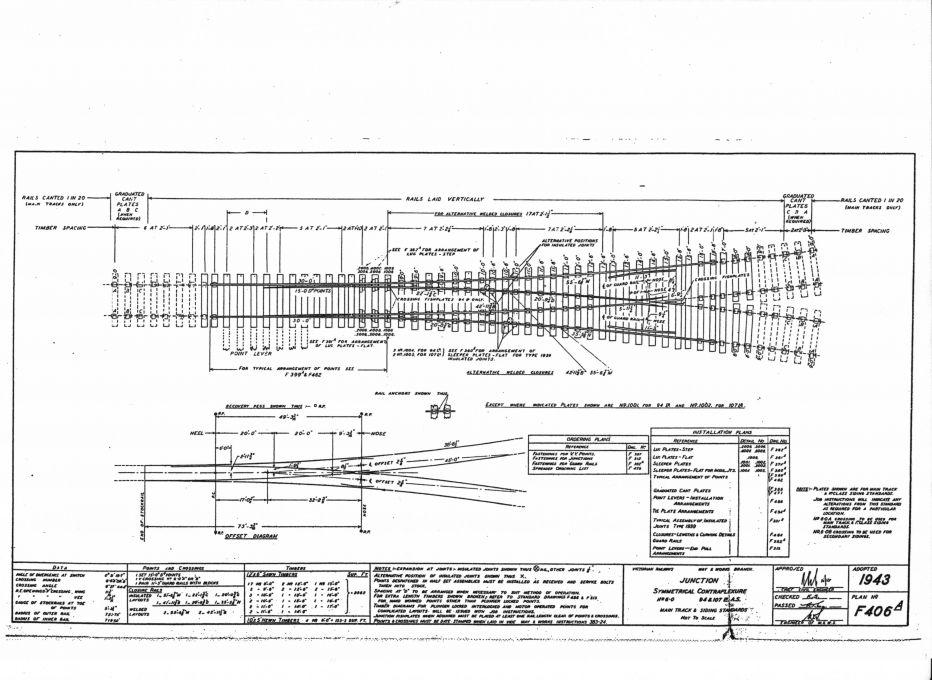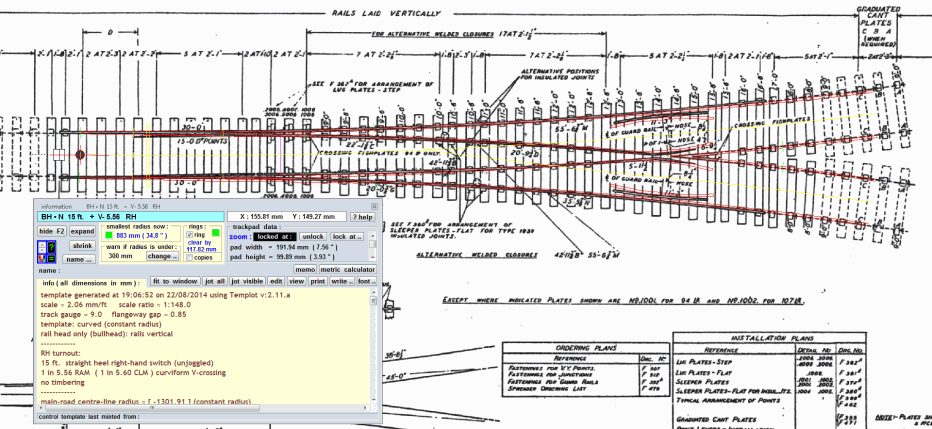Templot Club Archive 2007-2020
|
|||
| author | remove search highlighting | ||
|---|---|---|---|
|
posted: 21 Aug 2014 23:30 from: lukemac
click the date to link to this post click member name to view archived images |
Hi I need some help in building this symmetrical turnout. I'm modelling in N scale and not sure how to build this turnout in templot. Any help will be great. Luke2377_211829_480000000.jpg  |
||
|
posted: 22 Aug 2014 07:49 from: Hayfield
click the date to link to this post click member name to view archived images |
Luke Good morning (or afternoon where you are)There will be far more talented folk than me that will answer your question, but I thought I would get the ball rolling. They are tutorial and videos available on the site covering both methods Easy route Produce a normal template of the correct crossing angle from quick set in the Template section Place the centre of the heal over a horizontal line F6 will curve the turnout so the centre of the Vee moves over the horizontal line Ctrl+F10 (Swell) will alloy you to centralise the centre Change the Vee to a curviform one if needed in Real then V crossing options Adjust the timbers in Real then Shove timbers There are a couple of others bits to tidy it up but that gets it going Second method Scan the plan into Templot Overlay a turnout template (use Real Timbers remove timbers option initially) Now you can extend and bend the template as above, reverse the timber removal, then shove timbers Hope this helps John |
||
| Last edited on 22 Aug 2014 07:51 by Hayfield |
|||
|
posted: 22 Aug 2014 16:09 from: Brian Nicholls
click the date to link to this post click member name to view archived images |
Hi Luke, Just had a look at your turnout issue. You could almost achieve this with a simple turnout, see images below. The actual drawing you posted is, unfortunately, not absolutely accurate, it does however say that on the drawing, as 'not to scale'. So its a little out, particularly at the crossing area. As you can see from the below images, the basic fit looks quite reasonable. This was achieved by simply using a 15ft straight heel switch, as shown in the data panel on the second image. Hope this helps. All the best, Brian. 1853_221104_100000000.png  1853_221103_290000000.png  |
||
|
posted: 22 Aug 2014 19:27 from: Brian Nicholls
click the date to link to this post click member name to view archived images |
Hi Luke, Just to be sure, I used the same basic turnout, using N (UK) gauge. Again, as you can see from the below images, the basic fit looks quite reasonable. As a check of almost symmetry, I have set the grid to 10mm squares so you can see this (or just about due to the dark background). If you look at the grid scale at 110 on the left and if you follow that through the turnout, you can see it looks fairly symmetric at the exit roads, as shown in the second image. Hope this helps. All the best, Brian. 1853_221426_230000000.png  1853_221425_300000000.png  |
||
|
posted: 22 Aug 2014 21:12 from: Martin Wynne
click the date to link to this post click member name to view archived images |
Hi Luke, Welcome to Templot Club. For a symmetrical Y-turnout you may find it better to start with an irregular half-diamond template. More info here: topic 2036 - message 16699 and here: topic 2036 - message 13461 There is also an ancient tutorial on creating symmetrical turnouts, written before the irregular diamonds were introduced: http://www.templot.com/martweb/y_symm.htm Brian, if you need a better scan as a picture shape, Luke's original hi-res scan is here: gallery/2377/original/2377_211829_480000000.jpg Luke, there is enough information there to create a fully customized template from the prototype. But it is for 5ft-3in track gauge, which means you can't have an N gauge (9mm track gauge) version and still be fully prototypical in N scale. In American N scale (1:160) the track gauge would be 10.0mm exactly. In UK N scale (1:148) the track gauge would be 10.8mm. We need a bit more information here to know what you require. regards, Martin. |
||
|
posted: 22 Aug 2014 23:00 from: lukemac
click the date to link to this post click member name to view archived images |
Thanks everybody for the help. I will give it ago. Martin all tho the track plan is 5'3 gauge I'm still using the N scale NMRA standards. All my rolling stock that is based on the Victorian railways is made to the NMRA standard. Again thanks everyone and I tell you all how I go at. luke |
||
|
posted: 22 Aug 2014 23:16 from: Martin Wynne
click the date to link to this post click member name to view archived images |
Hi Luke, That's fine -- you just need to remember that a corresponding turnout will be shorter than scale in proportion to the gauge. So your model template will be 9/10ths of the length scaled from your drawing, for the same V-crossing (frog) angle. regards, Martin. |
||
|
posted: 27 Aug 2014 14:52 from: Brian Nicholls
click the date to link to this post click member name to view archived images |
Hi Luke, Because there appeared to be some issues with the F406 drawing of your symmetrical split Y turnout, and one could not successfully use it as a background image pattern in Templot, I decided to accurately drawn the template ( or pattern if you like) in CAD. I did this using only the dimensions shown of the drawing (and other drawings from the same source) to give an NMRA scaled (to 9mm) of the Y. The scale calc's used were: (drawing dimension in feet) x (1.91mm/ft) x (0.9, the difference in scale of the 5ft 3" to 4ft 8.5" proto gauges) This calculation was used for all scale dimensions with the exception of the flangeway gap, which is at the NMRA standard of 0.85mm. I have produced a PNG image as the output from the CAD drawing so that you can put it in Templot as the background image to then overlay your templates onto. To do this do the following: On the menu bar select < main > < background shapes Ctrl + S > In the first drop down menu ensure the radio buttons [ picture] and [ by entering dimensions] are both checked (selected), then click the [add shape] button. In the next menu click the third item down - [scanned model track plan [4]] in the next enter data menu, put in the following: X & Y co-ords = 0 (unless you have some templates in that area on the trackpad, then put in co-ords that put the image into a spare space. scanned dpi = 600 for both vertical and horizontal settings. in scale ratio put 1 (i.e. 1:1 scale) then click [ enter] twice. finally choose the symmetrical split Y drawing image. this will give you the image at the correct size to overlay your templates. Regarding the source of the drawings, I found them at the following site: http://www.victorianrailways.net/infastuct/infastructhome.html On the site, if you scroll half way down the page to an image, below that image is a fairly long list of F series drawings. These cover permanent way items (track work) and other infrastructure items such as buildings, bridges, water tanks and others. There appears to be no download facility, but you can readily copy and paste the drawing images. I hope the CAD image pattern helps. All the best, Brian. |
||
| Attachment: attach_1935_2517_Symmetrical_Split_Y_Turnout_Image.png 513 | |||
|
posted: 31 Aug 2014 02:00 from: lukemac
click the date to link to this post click member name to view archived images |
Thanks for the work you have done Brian. It was really good. Thanks for the run down on how to put the background shapes in as well. Victorian railways.net is a great site. I happen to work with the guy who runs the site. For those who are interested I have a blog on my modelling. To find stuff about my track work you will have to go and look at some of the older post. I've been busy with 3d printing, but have design some things for my track work. I will be getting but into it very soon so I will update with some more posting about track. find it here: http://bendigonscale.blogspot.com.au thanks luke |
||
| Please read this important note about copyright: Unless stated otherwise, all the files submitted to this web site are copyright and the property of the respective contributor. You are welcome to use them for your own personal non-commercial purposes, and in your messages on this web site. If you want to publish any of this material elsewhere or use it commercially, you must first obtain the owner's permission to do so. |